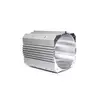Mobile:+86-311-808-126-83
Email:info@ydcastings.com
impeller investment casting
The Significance of Impeller Investment Casting in Modern Manufacturing
In the intricate world of modern manufacturing, precision and efficiency are two indispensable qualities that define successful production processes. One technique that has emerged as a game-changer in this regard is investment casting, particularly in the creation of impellers for various applications. Investment casting is a highly versatile manufacturing process that allows for the production of complex shapes with exceptional accuracy and surface finish.
Understanding Investment Casting
Investment casting, often referred to as lost-wax casting, involves creating a wax model of the part. This model is then coated in a ceramic shell, which is subsequently heated to remove the wax, leaving a hollow mold. Molten metal is poured into this mold, allowing manufacturers to create intricate designs that would be difficult or impossible to achieve through traditional machining methods. This process is particularly beneficial for producing impellers, which are critical components in a variety of industries, including aerospace, automotive, and marine engineering.
Impellers A Critical Component
Impellers are devices used to generate flow or increase the pressure of a fluid by converting rotational energy, typically from a motor or engine. They play a crucial role in systems such as pumps, turbines, and compressors. Given their functional importance, the performance of an impeller is heavily influenced by its design, material, and manufacturing process. The precise engineering of impellers is essential not only for efficiency but also for longevity under high-stress conditions.
Advantages of Investment Casting for Impellers
1. Complex Geometry Investment casting allows for the creation of intricate shapes and internal features that are often required for high-performance impellers. Traditional manufacturing methods may require multiple components and assembly, whereas investment casting can produce a single, seamless part.
2. High Dimensional Accuracy The investment casting process produces parts with excellent dimensional stability and tolerances. This level of precision is vital for impellers, where even minor deviations can lead to inefficiencies or failures in fluid dynamics.
impeller investment casting

3. Material Versatility Investment casting accommodates a wide range of materials, including high-performance alloys and stainless steel, which are commonly used for impellers. This versatility enables manufacturers to select materials that provide the best operational performance and corrosion resistance for specific applications.
4. Reduced Waste Unlike traditional subtractive manufacturing techniques, investment casting minimizes material waste by producing parts that closely match their final desired shape. This attribute not only contributes to cost savings but also supports sustainable manufacturing practices.
5. Enhanced Surface Finish Investment cast parts typically exhibit superior surface finishes, which can reduce or eliminate the need for secondary machining processes. A smooth surface finish is crucial for impellers, as it directly impacts fluid dynamics and efficiency.
Current Trends and Future Prospects
As industries continue to push for greater efficiency and performance, the demand for high-quality impellers produced through investment casting is expected to rise. Advances in technology, such as 3D printing and computer-aided design (CAD), are also enhancing the investment casting process, making it possible to produce even more complex and optimized designs.
Furthermore, with the growing emphasis on sustainability, the investment casting industry is exploring eco-friendly materials and processes to reduce its carbon footprint. Developing biodegradable binder systems and recyclable investment materials could revolutionize the practice, making it not only efficient but also environmentally responsible.
Conclusion
Investment casting has established itself as a critical process in the manufacturing of impellers, contributing significantly to various industries reliant on fluid dynamics. Its unique advantages of precision, material flexibility, and minimal waste make it an ideal choice for producing high-performance components. As technology continues to evolve, the future of investment casting in the production of impellers looks promising, setting the stage for innovations that will further enhance the efficiency and sustainability of modern manufacturing.
-
Why Should You Invest in Superior Pump Castings for Your Equipment?NewsJun.09,2025
-
Unlock Performance Potential with Stainless Impellers and Aluminum End CapsNewsJun.09,2025
-
Revolutionize Your Machinery with Superior Cast Iron and Aluminum ComponentsNewsJun.09,2025
-
Revolutionize Fluid Dynamics with Premium Pump ComponentsNewsJun.09,2025
-
Optimizing Industrial Systems with Essential Valve ComponentsNewsJun.09,2025
-
Elevate Grid Efficiency with High-Precision Power CastingsNewsJun.09,2025











